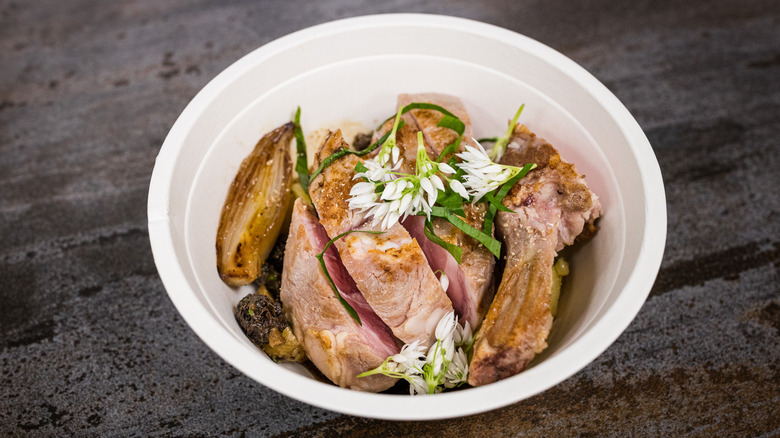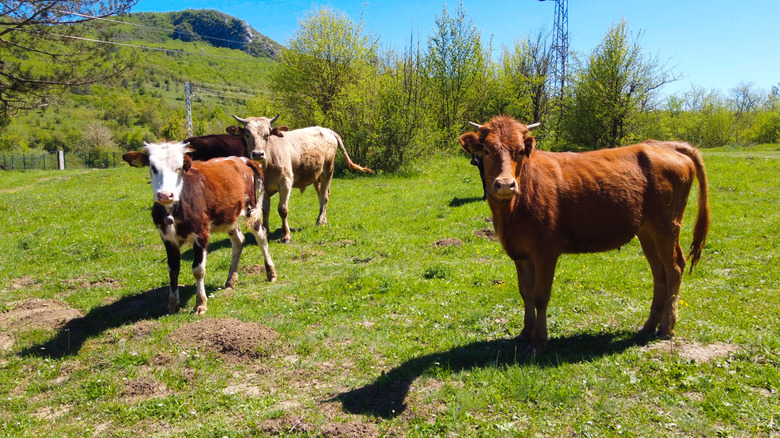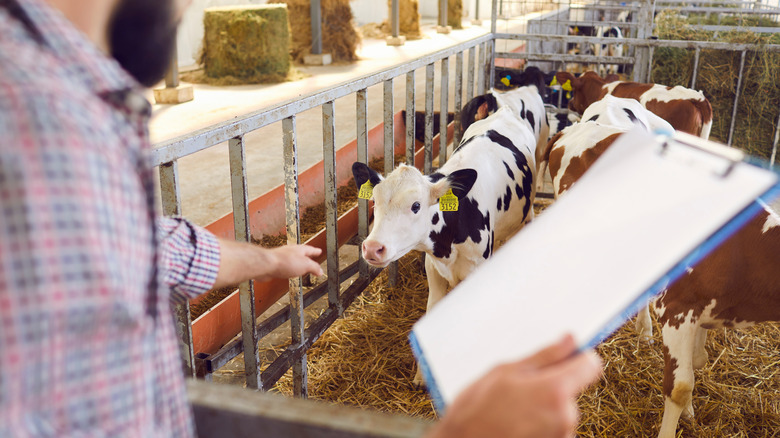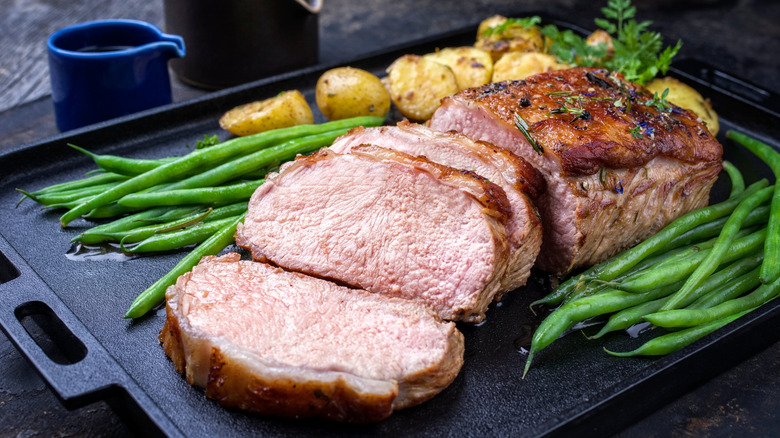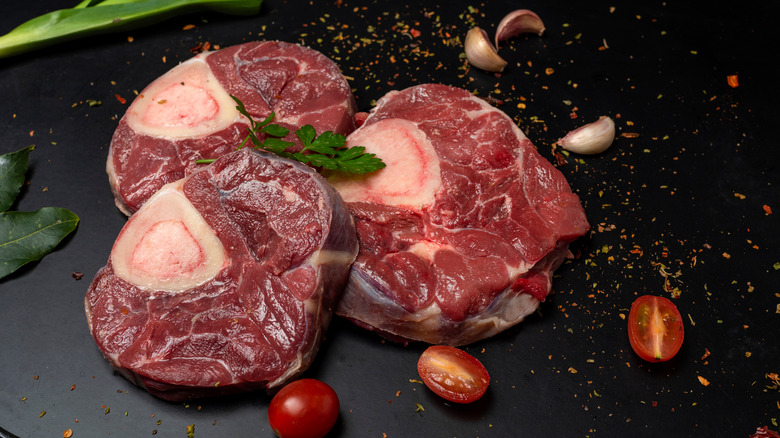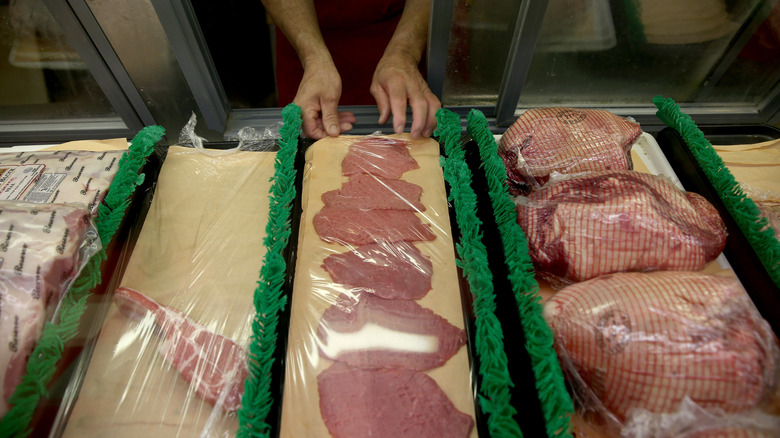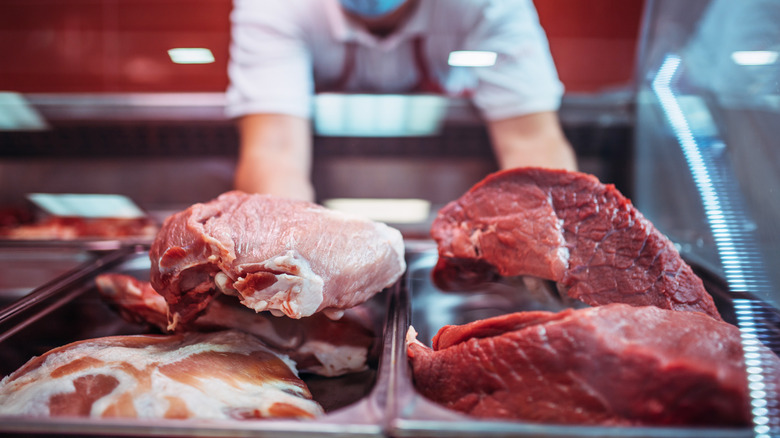What Exactly Is Veal And Why Is It So Expensive?
While not nearly as ubiquitous as chicken, beef, pork, or even lamb, veal is a relatively popular protein option in both restaurants and home kitchens. Veal is eaten in many forms: chops, shanks, cutlets, and ground meat, to name a few. It's most often used in dishes like osso bucco, veal scallopini, and meatballs, and veal stock is a mainstay in many classic sauces and reductions. But what exactly is veal? What differentiates it from beef? If you're ever pondered the notion of ethical veal consumption, you've come to the right place.
Allrecipes defines veal as a male calf under 18 weeks old. Bob veal is veal from very young calves (only about one month old), while milk-fed veal differs from formula-fed veal. Cattle that are slaughtered and eaten after 12 months of age are officially considered "beef."
The USDA notes that veal has multiple grades: prime, choice, good, standard, and utility, which notes the quality of the cut. The agency also explains that while hormones aren't used in veal raising, antibiotics may be. A statistic from the USDA's Economic Research Service in 2008 says that Americans consume less than a pound of veal per year per person. This is wildly different from beef, pork, and especially chicken consumption — data from Agricultural Economic Insights estimates that in 2016, Americans ate over 100 pounds of chicken per person per year.
What exactly causes the stigma for the veal industry? If it comes from the same animal as beef, what causes such a difference?
What is problematic about veal?
Historically, opposition to the veal industry is similar to ethical complaints against foie gras, namely that concern for the animals' welfare is nearly nonexistent at best, and abusive and harmful at worst. The "positive aspects" of veal — pale, tender flesh and a mild flavor — are direct results of the restrictive manner in which the cattle are raised.
Traditionally, veal production involved removing newborn calves from their mothers just after birth and limiting their movement in order to ensure uber-tender flesh. Some are also fed special diets to maintain pale flesh, essentially evoking anemia by reducing iron intake (via The Washington Post). Some calves slaughtered for veal are only months old. Because of this labor and general low supply, veal is much more expensive than beef. Cattle farmers also have a small window in which to rear and slaughter veal calves. This, of course, impacts price as well.
In the 1980s, veal production encountered large backlash from animal rights activists, as reported in outlets like the Washington Post. Since then, there have been changes, including elimination of veal crates, special pasture raising, allowing babies to stay with their mothers, and so on. The American Veal Association also no longer recommends the use of individual veal pens. It can also be argued that the demand for dairy products helps further veal production, since veal calves don't produce milk and are often fed with "co-products from dairy manufacturing," per Dairy Herd Management.
How has the industry's treatment of animals improved?
While the treatment of veal is now more paramount than ever, the ability to monitor every single cattle farmer raising veal is untenable. It's nearly impossible to ensure that they're all following the current, more humane conditions for raising veal calves. Edible Communities notes that many changes have taken place in the veal industry in recent years, which has helped foster more "humane" rearing and treatment, but of course, the end result is still killing and eating the animal. Veal crates, which severely limit the movement of young calves in order to maintain the meat's tender nature, are now immensely frowned upon, but there's no guarantee they've been eliminated entirely. The American Veal Association even writes that "state laws" banning veal crates "are not necessary because veal crates are no longer the industry practice for milk-fed veal."
Overall, however, the efforts to promote animal welfare and ethically raised animals prior to slaughter has become a primary focus in recent years, and in some instances, has led to changes in the law. The veal, foie gras, Kobe beef, and egg industries have undergone changes in recent years due to legislation.
Although Americans do not eat much veal, Edible Communities notes that as more humanely raised veal is produced, many feel much more comfortable in their consumption of the meat. Still, veal production remains a complicated issue.
What does veal taste like?
For a food made from the flesh of infant cows, veal must surely taste exquisite. After all, if it did not, we would be butchering babies for no good reason.
Well, the thing with veal is that the taste matters less than the texture. In a general discussion on ChowHound, a poster recalled how his cooking instructors taught them that veal holds little taste on its own, but has a sought after texture that pairs especially well with sauces. Respondents broadly agreed, bringing up filet mignon, a comparison that might get more at the heart of the matter.
Filet mignon, the once-prized steak, receives a good blasting on a Thrillist piece in which chefs picked their favorite and worst meats. "It's trash," chef Michael White bluntly states. "It is a non-working muscle, which makes it super tender (because the cow doesn't use it), but has no flavor and is only palatable when forced on a long airplane ride." Six other interviewed chefs agreed. Since veal comes from calves, none of their muscles have had time to develop into the toughened steaks that set the rest of the adult cow apart from the filet mignon. For those who enjoy veal, then, the taste and to a certain degree the veal itself matters very little. Rather, it is the pillowy softness of the meat that is important.
How do you use veal?
As veal is simply a more tender and youthful beef, you can approach cooking it in the same way that you could in the case of beef. You can have it ground for bolognese or burgers, breaded to serve as the basis for a cutlet, seared as short ribs, stuffed like a turkey breast, or skewered like a kebab.
One dish that is specifically made with veal in mind is osso buco, which means "pierced bone" in Italian. Our recipe for the dish comes from Keith Kamikawa and is time-consuming, but not challenging.
Start by tying up some veal shanks with twine. Season and sear the meat, then deglaze the pan with wine. Saute some mirepoix and garlic in butter, then add broth, diced tomatoes, herbs, and more wine. Submerge the veal shanks and let everything braise for two hours. When the meat is braised and tender, serve it over risotto or polenta and top it with an herby gremolata. Bon appetit!
Where to buy veal?
If you are so inclined, veal is not difficult to find. As this piece has beaten to a death similar to that of the calf, veal is simply meat sourced from an immature cow. So, you can easily purchase it from online retailers like FreshDirect. If you are looking for it in person, Costco may have it, as it lists veal as a product on their online shelves. And of course, you can always visit your local butcher to see what they're offering.
However, instead of listing every single store that might possibly sell this rather common ingredient, we will turn to the question of ethically eating veal. Many believe that veal, like lamb, is itself an ethical abomination, and claim that ethical veal cannot exist. Others argue that there is in fact a more ethical version, called rose veal. Rose veal, as Ecosalon explains, comes from calves raised in a free range environment to the age of six months. This, the piece notes, is both kinder and longer than what most pigs experience, and Edible Communities says this is also true of chickens. At a glance, you can tell the difference as the meat has a rosier color than the white veal alternative, which Edible Communities says gets its pallor from "a limited diet and total lack of activity."
However, while some American farmers do prefer the production of rose veal, there are no regulations requiring it to be prioritized over white veal.
Is veal nutritious?
When it comes to nutrition, the refrain continues: veal is beef but younger. So, veal has a broadly similar nutritional palate, but has more of pretty much everything.
According to Livestrong, three ounces of veal boasts 5.38 grams of fat, 2.15 grams of saturated fat, 114 milligrams of cholesterol, 30.7 grams of protein, and 57 milligrams of sodium. The same amount of beef contains 4.53 grams of fat, 1.63 grams of saturated fat, 77 milligrams of cholesterol, 30.3 grams of protein, and 38 milligrams of sodium. When it comes to vitamins and other minerals, the differences remain largely consistent, though beef has slightly more vitamin B12.
If you are looking for a nutritional alternative to beef, veal is not it, especially not if you're watching your cholesterol. Nor is there a health reason not to opt for beef over veal. Veal is beef but younger. If the ethical worries bother you not, then you can eat it with the same thought you would give beef.
